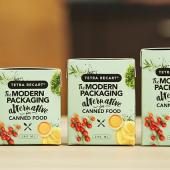Updates in Packaging Regulation
Important news in the European Parliament’s Environment Commission (ENVI), which has voted a series of amendments to the PPWR - Packaging and Packaging Waste Regulation text. At the time of going to press with the November/December edition of ItaliaImballaggio, we asked Francesca Siciliano Stevens, head of the general secretariat of Europen, the European association representing the packaging industry’s value chain, her first immediate reaction.
Maria Costanza Candi, Luciana Guidotti

Awaiting the vote of the Plenary Assembly, scheduled in Strasburg in the parliamentary week between 20 and 23 November, what emerges from the amendments voted by the Environment Commission at the end of October is a clear indication of an ideological position, which overshadows the role of packaging, also in the absence of environmental impact measuring methodologies such as the Life Cycle Assessment - LCA, which would make it possible to precisely establish what is sustainable and what is not.
Conditions are being created, on the other hand, for a substantial weakening of the single market, trade and the free movement of goods. Key Member States behind this evolution are pushing for solutions which are close to the state-of the-art in their respective countries, without taking into due consideration the centrality of the single market and the advantages of harmonization for investments.
The geography of the different positions
«The framework was outlined at the country-system level» Stevens begins. «If we look at the Council, it emerges that a number of states are pushing to have more flexibility, as is the case for France, Germany and Austria, which are aiming to raise reuse targets and are generally against the legislative instrument of regulation, as it could impose a harmonization that, in their opinion, is excessive. As for Italy, attention is focused on the key role of the recycling system, which in our country excels alongside few others, for example, Belgium. Apart from these exceptions, in fact, sorted collection and recycling work little and badly in the other European countries, complicating the path towards the desired circular economy».
The geography of the various positions also involves alliances such as, for example, between Italy and Finland, concerned about the impact that opposition to single-use could have on its plastic supply chain, regarding which Italy is an industrial leader, while the Scandinavian country is a leading producer of paper.
France, Germany and Austria, are, instead very focused on reuse regardless of the environmental and climatic impacts, while Spain doesn’t appear to have taken a net position, despite the fact that its agri-food supply chain would be in serious crisis if the regulation were to pass with the current guidelines.
Little recycling, many barriers
According to Europen, the failed implementation of effective recycling policies in all EU countries looks like a serious mistake both on an environmental level and with regards to strengthening the single market, and represents a major impediment for the industry, forced to incur extra costs to adapt to individual national regulations.
«Looking at the average recycling targets, in which Italy and few others are in line with the objectives - Stevens continues – the situation is even more worrying. The greater flexibility requested with insistence by national governments on the question of waste management goes, in fact, against the implementation of the circular economy because it fails to reinforce sorted collection obligations necessary for investments in collection, separation and recycling infrastructures at European level. These are two essential aspects for moving towards the desired strategic independence of materials and the harmonised single market for secondary materials. An emblematic example is given by plastic: the minimum recycled content goals which will be applied both to packaging and to parts in plastic will require considerable investments in infrastructures to ensure the volumes of recycled material necessary to meet legal obligations; otherwise, there is the risk of further increasing the EU’s strategic dependence on the supply of raw, secondary and non-raw materials. In addition, there is the decisive question of chemical recycling, with regards to which the methodology to define the contribution in terms of recycled material is under discussion in the SUP directive, in which the terms for both chemical and mechanical recycling are expected to be defined. It’s a central theme of the second implementing decree relating to the obligation of 30% of recycled material in PET by 2030, which will have a domino effect on the methodology of calculating the recycled content in plastic for the other objectives defined in the PPWR».
Protecting the single market to reinforce sustainability policies
According to Europen, the main aim of the Regulation is to provide the industry with adequate tools to govern processes at European level, in a political context in which the Commission’s harmonisation objective established in 1994 with the Packaging and Packaging Waste Directive (PPWD) is under attack due to the interest of individual States which are today discussing the PPWR, the natural evolution of the Directive.
«Europen is constantly focused on opposing this tendency of member States to impose limits to the single market. We find it worrying, in fact, that such an important and key objective aimed at investments, innovation and the circular economy is being lost sight of. This is why we believe that the industry must be compact on these themes, urging and imposing that the legislation is not conditioned by national interest but is guided by a unique and shared European regulation which, while respecting times and specificities, goes in the direction of market harmonisation».
To the vote!
In the environment Commission, the vote confirmed the tendency for ideological decisions, with amendments passed by very few votes in a context that confirms what was described by Francesca Stevens.
«Looking at article 6, a number of amendments approved go in the right direction; more clarity on large-scale recyclability timelines was, in fact, inserted, to prevent any delays by the Commission on implementing decrees. The clash, instead, occurred with regards to articles 26 and 22 annex 5, with reference to reuse and prohibitions in which there was a heated debate between the so-called “green” wing of the Parliament and the conservative wing. The alarming thing, once again, at the single market level, is that we see, on the one hand, negative signals with ever greater reuse target objectives, and on the other hand, the opening up to unilateral variations on the part of member States which have the freedom to construct a technical barrier for the free circulation of goods. We can take, for example, the obligation to put on labels membership of various national consortia – analogous to CONAI -, with evident differences of access imposed by the single national markets».
The growing lack of homogeneity seems to be generating an environmental orthodoxy that effectively limits the market despite the attempts to harmonise it with a specific regulation; member states and interest groups are today debasing with differentiated requests to economic operators. This is all to the detriment of the free circulation of goods and services. The ideological nature of a number of proposals emerges, moreover, from arbitrary prohibitions imposed against certain forms of packaging.
«The prohibitions proposed by the European Commission in annex V are arbitrary and not justified by scientific evidence – Stevens continues. This tendency worsened during the vote in the Environment Commission when, for example in annex V, further prohibitions were introduced, for example, on the use of film to protect baggage in airports or on the packages used by laundries, without any relevant evaluation of the impact made. With regards to the objectives of reuse, there continues to be a lack of any real connection with environmental impact assessment methodologies such as LCA, which would introduce into the discussion the sustainability of the model in various markets and would make it possible to provide for exemptions and compensations in the case of virtual behaviour on the part of enterprises and States. Lack of scientific basis and space for national interests; these, in short, are increasingly undermining the cornerstones of the single market and favouring unilateralism».
We will propose further examination of the themes in the coming editions of the magazine, in the light of the decisions taken by the Plenary Assembly in November.
On 24 October, the Environment Commission of the European Parliament took a position on the so-called packaging Regulation with 56 votes in favour, 23 against and 5 abstained.
Some key points of the proposals:
- the ban of the sale of plastic bags of a thickness less than 15 microns, apart from a number of exceptions of a hygienic nature and to reduce food waste;
- the reduction of plastic waste, including packaging and components, with the following timeline: 10% by 2030, 15% by 2035 and 20% by 2040;
- the introduction of a recycled percentage in the plastic parts making up packaging with targets established between 2030 and 2040;
- the definition of sustainability targets and criteria for bio-plastics by the Commission by 2025;
- the definition of reuse and refill concepts, including a minimum number of uses and the imposition for the HORECA and takeaway sectors to allow consumers to use their own containers;
- the ban on so-called “forever chemicals” if in contact with foods: perfluoroalkyl substances (PFAS) and Bisphenol A;
- the sorted waste target fixed at 90% by 2029 throughout the European Union;
- the request to the Commission to establish more stringent recycling requirements for packaging;
- the assimilation of online service providers with producers, with relative obligations



















